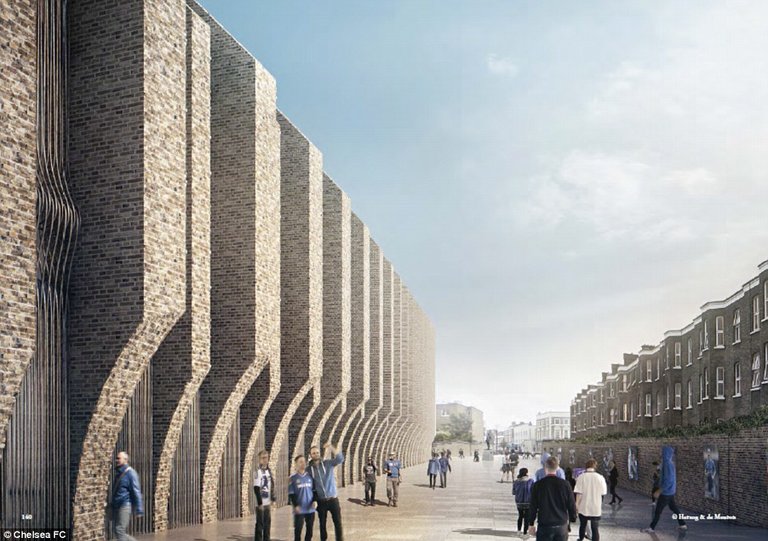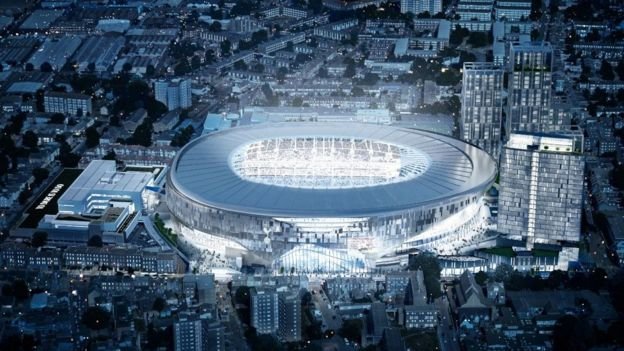.
With its own dedicated fromagerie, microbrewery and Michelin-star restaurant, it might be easy to forget you have come to watch the football when you are reclining in one of the premium lounges of Tottenham Hotspur’s new £750m stadium. The 61,000-seat behemoth will feature the longest bar in the country, heated seats with built-in USB ports, a glass-walled tunnel so you can see the players before the game and even a “sky walk” allowing fans to clamber over the roof of the arena.
As home entertainment systems become ever more elaborate, allowing fans to watch the action from every conceivable angle in ultra-high-definition, the conventional football stadium is having to up its game to lure people from the comfort of their homes. The promise of a pie, a pint and a good singsong in the stands just is not enough.

In its bid for the 2022 World Cup, Japan promised to record games in 360 degrees with 200 HD cameras and broadcast them around the world live in 3D, allowing players to appear in hundreds of stadiums simultaneously as holographic projections. Microphones embedded below the pitch would have recorded every ball kick and tackle whimper, adding to the sense of realism.
While Japan’s sci-fi dream lost out to the rippling vaginal vision of Qatar’s stadium plans, it is American football in the US that is now leading the way in developing next generation venues. Given the eye-watering sums generated from the sale of TV rights (with deals worth $27bn), each team in the National Football League is desperately trying to build bigger video screens and provide faster in-seat wifi than the next, even if most fans will never have the chance to experience it in person.

The new $1.6bn Atlanta Falcons stadium, currently under construction and due to open later this year, will feature the world’s first 360-degree video wall, running for 335m around the bowl, as well as a vast a rotating oculus roof, inspired by the wings of a falcon, made of eight 500-ton moving pieces. At one point it was even going to include vibrating seats.
“NFL has become an arms race,” says the architect John Rhodes of HOK, the firm behind the Atlanta project. “It used to be about sheer size, but now everyone’s focused on the convergence of the physical and digital experience, increasing connectivity in the stadium to bring fans closer to the players.”

He sees a future where the seating bowl might be fragmented into smaller groups of 50-100 people, creating “group suites” to intensify the physical and social interaction between fans, while drones will become a ubiquitous feature.
“I don’t imagine drones will be delivering beers to your seat, as some people think,” he says, “but I can definitely see linear bars served by drones running around the outside of concourse. It could have a revolutionary impact on how we think of concessions and eliminate queuing.”


Others are less enamoured with the high-tech dream. Jacques Herzog of Herzog & de Meuron, the Pritzker Prize-winning Swiss architects behind several renowned stadiums, from the inflatable bubble of the Allianz Arena in Munich to the steel tangle of Beijing Bird’s Nest, to the colossal brick cathedral of Chelsea’s forthcoming new stadium, thinks it might all be a distraction.
“Everything is becoming too artificial,” he says. “It’s like when I watch my son playing Fifa on his console. If you have artificial lawns and roofs to keep out the rain and snow, you lose the physical authenticity of the moment and make it more of a virtual thing.”

He says his focus is always on capturing the local specificity of the place, designing a venue that somehow responds to the fan culture of the team in question, whether that’s a glowing lantern for Munich, a sharp white temple for Bordeaux, or an archaic masonry complex of vaults and buttresses for Stamford Bridge. For every project his practice reinvents the model.


“Our Bordeaux stadium is very refined to fit with the city’s elegant urban plan, but in London this would be absurd,” he says. “Equally if we took our Stamford Bridge project to Munich it would look like Lord of the Rings.” He describes his forthcoming Chelsea stadium as “almost Roman” in its raw heft, the polar opposite to Tottenham’s shiny UFO.
“Above all,” he adds, “both football and architecture need to keep that sense of the real. The smell of the grass, the proximity of the players to the fans. People come to watch games to have all of their senses stimulated – that’s what architecture must amplify.”

.
Source:
https://www.theguardian.com/sport

Follow @ifzgotdatpiff
Thanks :)

Hi! I am a robot. I just upvoted you! I found similar content that readers might be interested in:
https://www.theguardian.com/sport/2017/jun/15/stadiums-future-holograms-drones-fan-experience
Congratulations @ifzgotdatpiff! You received a personal award!
You can view your badges on your Steem Board and compare to others on the Steem Ranking
Vote for @Steemitboard as a witness to get one more award and increased upvotes!